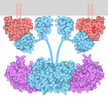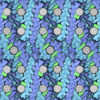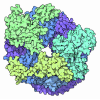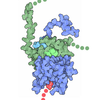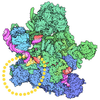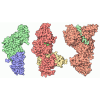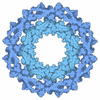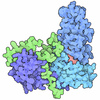+ データを開く
データを開く
- 基本情報
基本情報
| 登録情報 | データベース: PDB / ID: 8dp5 | ||||||||||||
|---|---|---|---|---|---|---|---|---|---|---|---|---|---|
| タイトル | Structure of the PEAK3/14-3-3 complex | ||||||||||||
 要素 要素 |
| ||||||||||||
 キーワード キーワード | SIGNALING PROTEIN / complex / pseudokinase / kinase / adapter | ||||||||||||
| 機能・相同性 |  機能・相同性情報 機能・相同性情報regulation of heart rate by hormone / positive regulation of hippo signaling / membrane repolarization during cardiac muscle cell action potential / Tristetraprolin (TTP, ZFP36) binds and destabilizes mRNA / Butyrate Response Factor 1 (BRF1) binds and destabilizes mRNA / negative regulation of toll-like receptor signaling pathway / protein localization to endoplasmic reticulum / regulation of membrane repolarization / NADE modulates death signalling / MTOR signalling ...regulation of heart rate by hormone / positive regulation of hippo signaling / membrane repolarization during cardiac muscle cell action potential / Tristetraprolin (TTP, ZFP36) binds and destabilizes mRNA / Butyrate Response Factor 1 (BRF1) binds and destabilizes mRNA / negative regulation of toll-like receptor signaling pathway / protein localization to endoplasmic reticulum / regulation of membrane repolarization / NADE modulates death signalling / MTOR signalling / regulation of cell motility / ARMS-mediated activation / RAB GEFs exchange GTP for GDP on RABs / SHOC2 M1731 mutant abolishes MRAS complex function / Gain-of-function MRAS complexes activate RAF signaling / Rap1 signalling / Signaling by Hippo / regulation of potassium ion transmembrane transport / vacuolar membrane / negative regulation of G protein-coupled receptor signaling pathway / protein phosphatase inhibitor activity / Frs2-mediated activation / negative regulation of protein import into nucleus / cytoplasmic pattern recognition receptor signaling pathway / Deregulated CDK5 triggers multiple neurodegenerative pathways in Alzheimer's disease models / negative regulation of calcium ion export across plasma membrane / protein kinase inhibitor activity / intracellular potassium ion homeostasis / regulation of heart rate by cardiac conduction / mTORC1-mediated signalling / Regulation of localization of FOXO transcription factors / Regulation of HSF1-mediated heat shock response / protein localization to nucleus / phosphoserine residue binding / Activation of BAD and translocation to mitochondria / HSF1 activation / regulation of cytosolic calcium ion concentration / potassium channel regulator activity / protein targeting / Chk1/Chk2(Cds1) mediated inactivation of Cyclin B:Cdk1 complex / SARS-CoV-2 targets host intracellular signalling and regulatory pathways / calcium channel inhibitor activity / RHO GTPases activate PKNs / SARS-CoV-1 targets host intracellular signalling and regulatory pathways / signaling adaptor activity / transcription repressor complex / Loss of Nlp from mitotic centrosomes / Loss of proteins required for interphase microtubule organization from the centrosome / Transcriptional and post-translational regulation of MITF-M expression and activity / substantia nigra development / Recruitment of mitotic centrosome proteins and complexes / Recruitment of NuMA to mitotic centrosomes / Anchoring of the basal body to the plasma membrane / protein sequestering activity / regulation of mitotic cell cycle / AURKA Activation by TPX2 / positive regulation of protein export from nucleus / regulation of actin cytoskeleton organization / TP53 Regulates Metabolic Genes / calcium channel regulator activity / Translocation of SLC2A4 (GLUT4) to the plasma membrane / hippocampus development / phosphoprotein binding / RAF activation / Signaling by high-kinase activity BRAF mutants / MAP2K and MAPK activation / mitochondrial membrane / cerebral cortex development / histone deacetylase binding / neuron migration / Negative regulation of MAPK pathway / Signaling by RAF1 mutants / Signaling by moderate kinase activity BRAF mutants / Paradoxical activation of RAF signaling by kinase inactive BRAF / Signaling downstream of RAS mutants / MHC class II protein complex binding / Signaling by BRAF and RAF1 fusions / Regulation of PLK1 Activity at G2/M Transition / melanosome / intracellular protein localization / MAPK cascade / regulation of cell shape / actin cytoskeleton / cellular response to heat / scaffold protein binding / protein phosphatase binding / transmembrane transporter binding / protein kinase activity / intracellular signal transduction / cadherin binding / protein heterodimerization activity / protein domain specific binding / focal adhesion / negative regulation of DNA-templated transcription / ubiquitin protein ligase binding / protein-containing complex binding / perinuclear region of cytoplasm / enzyme binding / endoplasmic reticulum / signal transduction 類似検索 - 分子機能 | ||||||||||||
| 生物種 |  Homo sapiens (ヒト) Homo sapiens (ヒト) | ||||||||||||
| 手法 | 電子顕微鏡法 / 単粒子再構成法 / クライオ電子顕微鏡法 / 解像度: 3.1 Å | ||||||||||||
 データ登録者 データ登録者 | Torosyan, H. / Paul, M. / Jura, N. / Verba, K.A. | ||||||||||||
| 資金援助 |  米国, 3件 米国, 3件
| ||||||||||||
 引用 引用 |  ジャーナル: Nat Commun / 年: 2023 ジャーナル: Nat Commun / 年: 2023タイトル: Structural insights into regulation of the PEAK3 pseudokinase scaffold by 14-3-3. 著者: Hayarpi Torosyan / Michael D Paul / Antoine Forget / Megan Lo / Devan Diwanji / Krzysztof Pawłowski / Nevan J Krogan / Natalia Jura / Kliment A Verba /   要旨: PEAK pseudokinases are molecular scaffolds which dimerize to regulate cell migration, morphology, and proliferation, as well as cancer progression. The mechanistic role dimerization plays in PEAK ...PEAK pseudokinases are molecular scaffolds which dimerize to regulate cell migration, morphology, and proliferation, as well as cancer progression. The mechanistic role dimerization plays in PEAK scaffolding remains unclear, as there are no structures of PEAKs in complex with their interactors. Here, we report the cryo-EM structure of dimeric PEAK3 in complex with an endogenous 14-3-3 heterodimer. Our structure reveals an asymmetric binding mode between PEAK3 and 14-3-3 stabilized by one pseudokinase domain and the SHED domain of the PEAK3 dimer. The binding interface contains a canonical phosphosite-dependent primary interaction and a unique secondary interaction not observed in previous structures of 14-3-3/client complexes. Additionally, we show that PKD regulates PEAK3/14-3-3 binding, which when prevented leads to PEAK3 nuclear enrichment and distinct protein-protein interactions. Altogether, our data demonstrate that PEAK3 dimerization forms an unusual secondary interface for 14-3-3 binding, facilitating 14-3-3 regulation of PEAK3 localization and interactome diversity. | ||||||||||||
| 履歴 |
|
- 構造の表示
構造の表示
| 構造ビューア | 分子:  Molmil Molmil Jmol/JSmol Jmol/JSmol |
|---|
- ダウンロードとリンク
ダウンロードとリンク
- ダウンロード
ダウンロード
| PDBx/mmCIF形式 |  8dp5.cif.gz 8dp5.cif.gz | 435.5 KB | 表示 |  PDBx/mmCIF形式 PDBx/mmCIF形式 |
|---|---|---|---|---|
| PDB形式 |  pdb8dp5.ent.gz pdb8dp5.ent.gz | 351.2 KB | 表示 |  PDB形式 PDB形式 |
| PDBx/mmJSON形式 |  8dp5.json.gz 8dp5.json.gz | ツリー表示 |  PDBx/mmJSON形式 PDBx/mmJSON形式 | |
| その他 |  その他のダウンロード その他のダウンロード |
-検証レポート
| 文書・要旨 |  8dp5_validation.pdf.gz 8dp5_validation.pdf.gz | 1.4 MB | 表示 |  wwPDB検証レポート wwPDB検証レポート |
|---|---|---|---|---|
| 文書・詳細版 |  8dp5_full_validation.pdf.gz 8dp5_full_validation.pdf.gz | 1.4 MB | 表示 | |
| XML形式データ |  8dp5_validation.xml.gz 8dp5_validation.xml.gz | 45.3 KB | 表示 | |
| CIF形式データ |  8dp5_validation.cif.gz 8dp5_validation.cif.gz | 68.3 KB | 表示 | |
| アーカイブディレクトリ |  https://data.pdbj.org/pub/pdb/validation_reports/dp/8dp5 https://data.pdbj.org/pub/pdb/validation_reports/dp/8dp5 ftp://data.pdbj.org/pub/pdb/validation_reports/dp/8dp5 ftp://data.pdbj.org/pub/pdb/validation_reports/dp/8dp5 | HTTPS FTP |
-関連構造データ
| 関連構造データ | 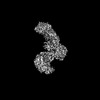 27630MC  8ds6C M: このデータのモデリングに利用したマップデータ C: 同じ文献を引用 ( |
|---|---|
| 類似構造データ | 類似検索 - 機能・相同性  F&H 検索 F&H 検索 |
- リンク
リンク
- 集合体
集合体
| 登録構造単位 | 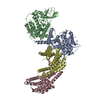
|
|---|---|
| 1 |
|
- 要素
要素
| #1: タンパク質 | 分子量: 52357.031 Da / 分子数: 2 / 由来タイプ: 組換発現 / 由来: (組換発現)  Homo sapiens (ヒト) / 遺伝子: PEAK3, C19orf35 / 細胞株 (発現宿主): Expi293 / 発現宿主: Homo sapiens (ヒト) / 遺伝子: PEAK3, C19orf35 / 細胞株 (発現宿主): Expi293 / 発現宿主:  Homo sapiens (ヒト) / 参照: UniProt: Q6ZS72 Homo sapiens (ヒト) / 参照: UniProt: Q6ZS72#2: タンパク質 | | 分子量: 28114.373 Da / 分子数: 1 / 由来タイプ: 組換発現 / 由来: (組換発現)  Homo sapiens (ヒト) / 遺伝子: YWHAB / 発現宿主: Homo sapiens (ヒト) / 遺伝子: YWHAB / 発現宿主:  Homo sapiens (ヒト) / 参照: UniProt: P31946 Homo sapiens (ヒト) / 参照: UniProt: P31946#3: タンパク質 | | 分子量: 29208.900 Da / 分子数: 1 / 由来タイプ: 組換発現 / 由来: (組換発現)  Homo sapiens (ヒト) / 遺伝子: YWHAE / 発現宿主: Homo sapiens (ヒト) / 遺伝子: YWHAE / 発現宿主:  Homo sapiens (ヒト) / 参照: UniProt: P62258 Homo sapiens (ヒト) / 参照: UniProt: P62258#4: タンパク質 | 分子量: 52437.012 Da / 分子数: 2 / 由来タイプ: 組換発現 / 由来: (組換発現)  Homo sapiens (ヒト) / 遺伝子: PEAK3, C19orf35 / 発現宿主: Homo sapiens (ヒト) / 遺伝子: PEAK3, C19orf35 / 発現宿主:  Homo sapiens (ヒト) / 参照: UniProt: Q6ZS72 Homo sapiens (ヒト) / 参照: UniProt: Q6ZS72構成要素の詳細 | The authors state that chains E and P are part of Chains A and B. However, because they cannot ...The authors state that chains E and P are part of Chains A and B. However, because they cannot resolve a large portion of the N-terminal segments of Chain A and B and therefore the connectivity between these two sets of chains, they cannot with confidence assign Chain E residues to Chains A or B and the same with Chain P residues. | 研究の焦点であるリガンドがあるか | N | Has protein modification | Y | |
|---|
-実験情報
-実験
| 実験 | 手法: 電子顕微鏡法 |
|---|---|
| EM実験 | 試料の集合状態: PARTICLE / 3次元再構成法: 単粒子再構成法 |
- 試料調製
試料調製
| 構成要素 | 名称: Complex between PEAK3 and 14-3-3 epsilon, beta / タイプ: COMPLEX / Entity ID: all / 由来: RECOMBINANT | |||||||||||||||||||||||||
|---|---|---|---|---|---|---|---|---|---|---|---|---|---|---|---|---|---|---|---|---|---|---|---|---|---|---|
| 分子量 | 値: 0.1618 MDa / 実験値: NO | |||||||||||||||||||||||||
| 由来(天然) | 生物種:  Homo sapiens (ヒト) Homo sapiens (ヒト) | |||||||||||||||||||||||||
| 由来(組換発現) | 生物種:  Homo sapiens (ヒト) Homo sapiens (ヒト) | |||||||||||||||||||||||||
| 緩衝液 | pH: 7.5 詳細: A final concentration of 0.1% of Octyl-beta-Glucoside (C14H28O6) was added to the sample before freezing. | |||||||||||||||||||||||||
| 緩衝液成分 |
| |||||||||||||||||||||||||
| 試料 | 濃度: 1.1 mg/ml / 包埋: NO / シャドウイング: NO / 染色: NO / 凍結: YES | |||||||||||||||||||||||||
| 試料支持 | グリッドの材料: GOLD / グリッドのサイズ: 300 divisions/in. / グリッドのタイプ: Quantifoil R1.2/1.3 | |||||||||||||||||||||||||
| 急速凍結 | 装置: FEI VITROBOT MARK IV / 凍結剤: ETHANE / 湿度: 100 % / 凍結前の試料温度: 278.15 K / 詳細: blot time = 7s blot force = 4 |
- 電子顕微鏡撮影
電子顕微鏡撮影
| 実験機器 |  モデル: Titan Krios / 画像提供: FEI Company |
|---|---|
| 顕微鏡 | モデル: FEI TITAN KRIOS |
| 電子銃 | 電子線源:  FIELD EMISSION GUN / 加速電圧: 300 kV / 照射モード: FLOOD BEAM FIELD EMISSION GUN / 加速電圧: 300 kV / 照射モード: FLOOD BEAM |
| 電子レンズ | モード: BRIGHT FIELD / 倍率(公称値): 105000 X / 最大 デフォーカス(公称値): 2000 nm / 最小 デフォーカス(公称値): 1000 nm / アライメント法: COMA FREE |
| 試料ホルダ | 凍結剤: NITROGEN 試料ホルダーモデル: FEI TITAN KRIOS AUTOGRID HOLDER |
| 撮影 | 電子線照射量: 69 e/Å2 / フィルム・検出器のモデル: GATAN K3 (6k x 4k) / 撮影したグリッド数: 1 |
| 電子光学装置 | エネルギーフィルター名称: GIF Bioquantum / エネルギーフィルタースリット幅: 20 eV |
- 解析
解析
| EMソフトウェア |
| ||||||||||||||||||||||||||||||||||||||||||||
|---|---|---|---|---|---|---|---|---|---|---|---|---|---|---|---|---|---|---|---|---|---|---|---|---|---|---|---|---|---|---|---|---|---|---|---|---|---|---|---|---|---|---|---|---|---|
| CTF補正 | タイプ: PHASE FLIPPING AND AMPLITUDE CORRECTION | ||||||||||||||||||||||||||||||||||||||||||||
| 3次元再構成 | 解像度: 3.1 Å / 解像度の算出法: FSC 0.143 CUT-OFF / 粒子像の数: 169563 / 対称性のタイプ: POINT |
 ムービー
ムービー コントローラー
コントローラー




 PDBj
PDBj